Evaluating Capital Budgeting Tools for Project Selection
VerifiedAdded on 2020/03/28
|9
|1963
|96
AI Summary
The assignment examines the role of sensitivity and scenario analyses in capital budgeting, focusing on their impact on Net Present Value (NPV) and Internal Rate of Return (IRR). Students are expected to analyze how these tools help in mitigating risks associated with investment decisions by considering different variables and market conditions. The study will include discussions on break-even analysis and its importance in cost management and competitive strategy. Through this analysis, students will gain insights into making informed investment choices that maximize profitability and value creation.
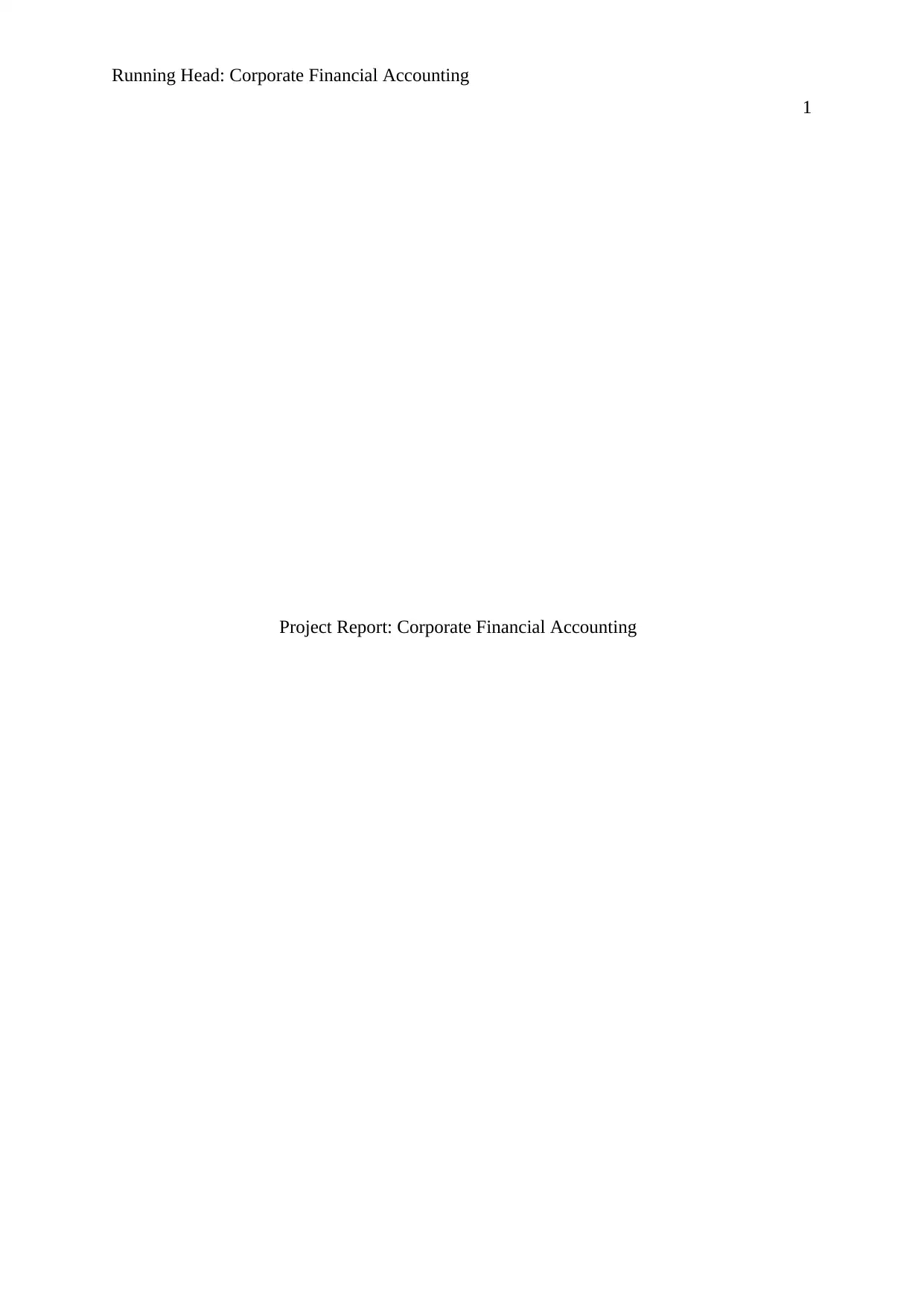
Running Head: Corporate Financial Accounting
1
Project Report: Corporate Financial Accounting
1
Project Report: Corporate Financial Accounting
Paraphrase This Document
Need a fresh take? Get an instant paraphrase of this document with our AI Paraphraser
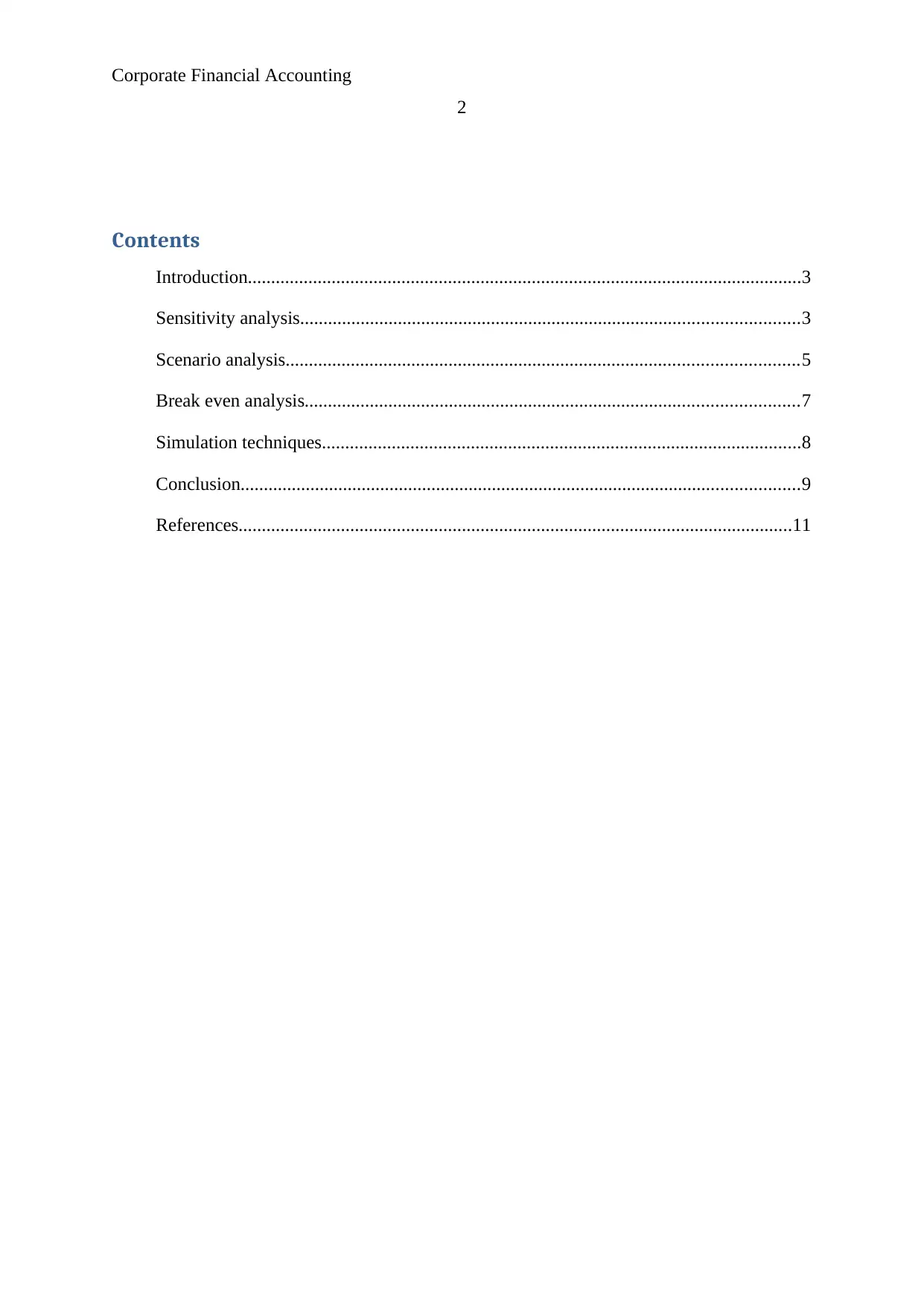
Corporate Financial Accounting
2
Contents
Introduction.......................................................................................................................3
Sensitivity analysis...........................................................................................................3
Scenario analysis..............................................................................................................5
Break even analysis..........................................................................................................7
Simulation techniques.......................................................................................................8
Conclusion........................................................................................................................9
References.......................................................................................................................11
2
Contents
Introduction.......................................................................................................................3
Sensitivity analysis...........................................................................................................3
Scenario analysis..............................................................................................................5
Break even analysis..........................................................................................................7
Simulation techniques.......................................................................................................8
Conclusion........................................................................................................................9
References.......................................................................................................................11

Corporate Financial Accounting
3
Introduction:
Organization is accompanied with the complex set of activities in which various
functions are performed with a view to achieve certain level of goals and objective. There are
several financial tools such as ratio analysis, capital budgeting tools, NPV IRR, profitability
analysis. These tools are used by investors or companies to evaluate the best suitable
investment option which could be undertaken by organization to make effective use of
resources in organization. It is observed that Net present value and IRR are the most suitable
financial tools to select the most profitable project in the given options. It is evaluated that if
companies could use these capital budgeting tools in effective manner then it will increase the
overall investment value. (Zimmerman and Yahya-Zadeh, 2011). Ideally, these capital
budgeting tools are used by organization when long term investment decisions are made. For
instance, when Company ABC wants to invest AUD $ 1, 00,000 in particular project.
Company is having 5 project options to invest its capital. In this case, project giving higher
NPV and IRR will be accepted by the organization. It is considered that Net present value not
only reflects the higher cash outflow but also showcases the present value of the investment
or present value of cash inflow and outflow of business which it will have in future. This
level of financial tools could be useful to create best value on the invested capital (Bier man
and Smidt, 2012).
It is evaluated that corporate decision are the key pillar for the success of
organization. Investment in the particular project options may result to destruction of
business if these are not taken in proper specific manner (Bennouna, et al. 2010).Financial
tools such as ratio analysis, capital budgeting tools, NPV IRR, profitability analysis provide
deep understanding on the associated financial factors of business. This will increase the
overall project effectiveness and business and investment decisions (Gervais, Heaton and
3
Introduction:
Organization is accompanied with the complex set of activities in which various
functions are performed with a view to achieve certain level of goals and objective. There are
several financial tools such as ratio analysis, capital budgeting tools, NPV IRR, profitability
analysis. These tools are used by investors or companies to evaluate the best suitable
investment option which could be undertaken by organization to make effective use of
resources in organization. It is observed that Net present value and IRR are the most suitable
financial tools to select the most profitable project in the given options. It is evaluated that if
companies could use these capital budgeting tools in effective manner then it will increase the
overall investment value. (Zimmerman and Yahya-Zadeh, 2011). Ideally, these capital
budgeting tools are used by organization when long term investment decisions are made. For
instance, when Company ABC wants to invest AUD $ 1, 00,000 in particular project.
Company is having 5 project options to invest its capital. In this case, project giving higher
NPV and IRR will be accepted by the organization. It is considered that Net present value not
only reflects the higher cash outflow but also showcases the present value of the investment
or present value of cash inflow and outflow of business which it will have in future. This
level of financial tools could be useful to create best value on the invested capital (Bier man
and Smidt, 2012).
It is evaluated that corporate decision are the key pillar for the success of
organization. Investment in the particular project options may result to destruction of
business if these are not taken in proper specific manner (Bennouna, et al. 2010).Financial
tools such as ratio analysis, capital budgeting tools, NPV IRR, profitability analysis provide
deep understanding on the associated financial factors of business. This will increase the
overall project effectiveness and business and investment decisions (Gervais, Heaton and
⊘ This is a preview!⊘
Do you want full access?
Subscribe today to unlock all pages.

Trusted by 1+ million students worldwide
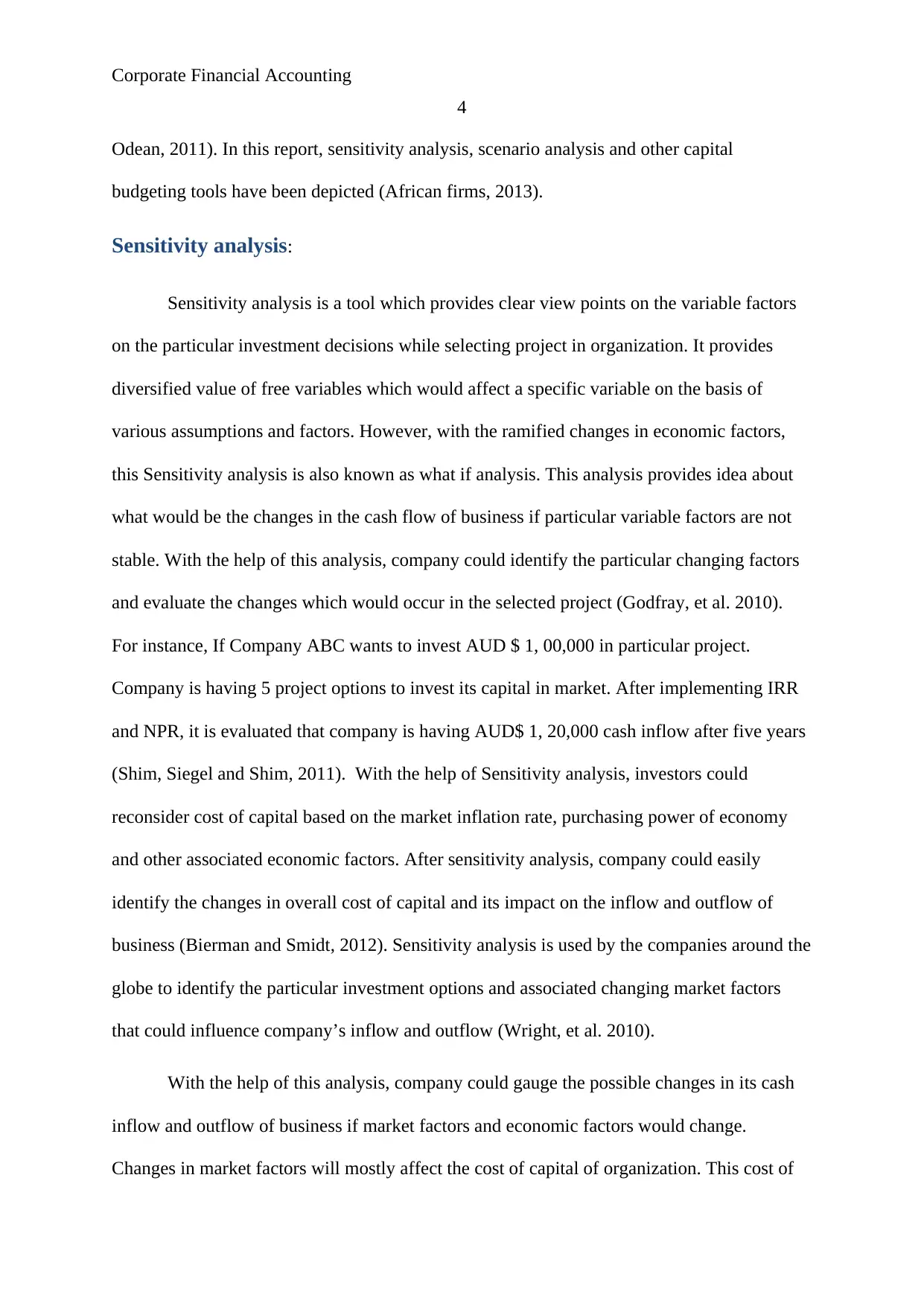
Corporate Financial Accounting
4
Odean, 2011). In this report, sensitivity analysis, scenario analysis and other capital
budgeting tools have been depicted (African firms, 2013).
Sensitivity analysis:
Sensitivity analysis is a tool which provides clear view points on the variable factors
on the particular investment decisions while selecting project in organization. It provides
diversified value of free variables which would affect a specific variable on the basis of
various assumptions and factors. However, with the ramified changes in economic factors,
this Sensitivity analysis is also known as what if analysis. This analysis provides idea about
what would be the changes in the cash flow of business if particular variable factors are not
stable. With the help of this analysis, company could identify the particular changing factors
and evaluate the changes which would occur in the selected project (Godfray, et al. 2010).
For instance, If Company ABC wants to invest AUD $ 1, 00,000 in particular project.
Company is having 5 project options to invest its capital in market. After implementing IRR
and NPR, it is evaluated that company is having AUD$ 1, 20,000 cash inflow after five years
(Shim, Siegel and Shim, 2011). With the help of Sensitivity analysis, investors could
reconsider cost of capital based on the market inflation rate, purchasing power of economy
and other associated economic factors. After sensitivity analysis, company could easily
identify the changes in overall cost of capital and its impact on the inflow and outflow of
business (Bierman and Smidt, 2012). Sensitivity analysis is used by the companies around the
globe to identify the particular investment options and associated changing market factors
that could influence company’s inflow and outflow (Wright, et al. 2010).
With the help of this analysis, company could gauge the possible changes in its cash
inflow and outflow of business if market factors and economic factors would change.
Changes in market factors will mostly affect the cost of capital of organization. This cost of
4
Odean, 2011). In this report, sensitivity analysis, scenario analysis and other capital
budgeting tools have been depicted (African firms, 2013).
Sensitivity analysis:
Sensitivity analysis is a tool which provides clear view points on the variable factors
on the particular investment decisions while selecting project in organization. It provides
diversified value of free variables which would affect a specific variable on the basis of
various assumptions and factors. However, with the ramified changes in economic factors,
this Sensitivity analysis is also known as what if analysis. This analysis provides idea about
what would be the changes in the cash flow of business if particular variable factors are not
stable. With the help of this analysis, company could identify the particular changing factors
and evaluate the changes which would occur in the selected project (Godfray, et al. 2010).
For instance, If Company ABC wants to invest AUD $ 1, 00,000 in particular project.
Company is having 5 project options to invest its capital in market. After implementing IRR
and NPR, it is evaluated that company is having AUD$ 1, 20,000 cash inflow after five years
(Shim, Siegel and Shim, 2011). With the help of Sensitivity analysis, investors could
reconsider cost of capital based on the market inflation rate, purchasing power of economy
and other associated economic factors. After sensitivity analysis, company could easily
identify the changes in overall cost of capital and its impact on the inflow and outflow of
business (Bierman and Smidt, 2012). Sensitivity analysis is used by the companies around the
globe to identify the particular investment options and associated changing market factors
that could influence company’s inflow and outflow (Wright, et al. 2010).
With the help of this analysis, company could gauge the possible changes in its cash
inflow and outflow of business if market factors and economic factors would change.
Changes in market factors will mostly affect the cost of capital of organization. This cost of
Paraphrase This Document
Need a fresh take? Get an instant paraphrase of this document with our AI Paraphraser
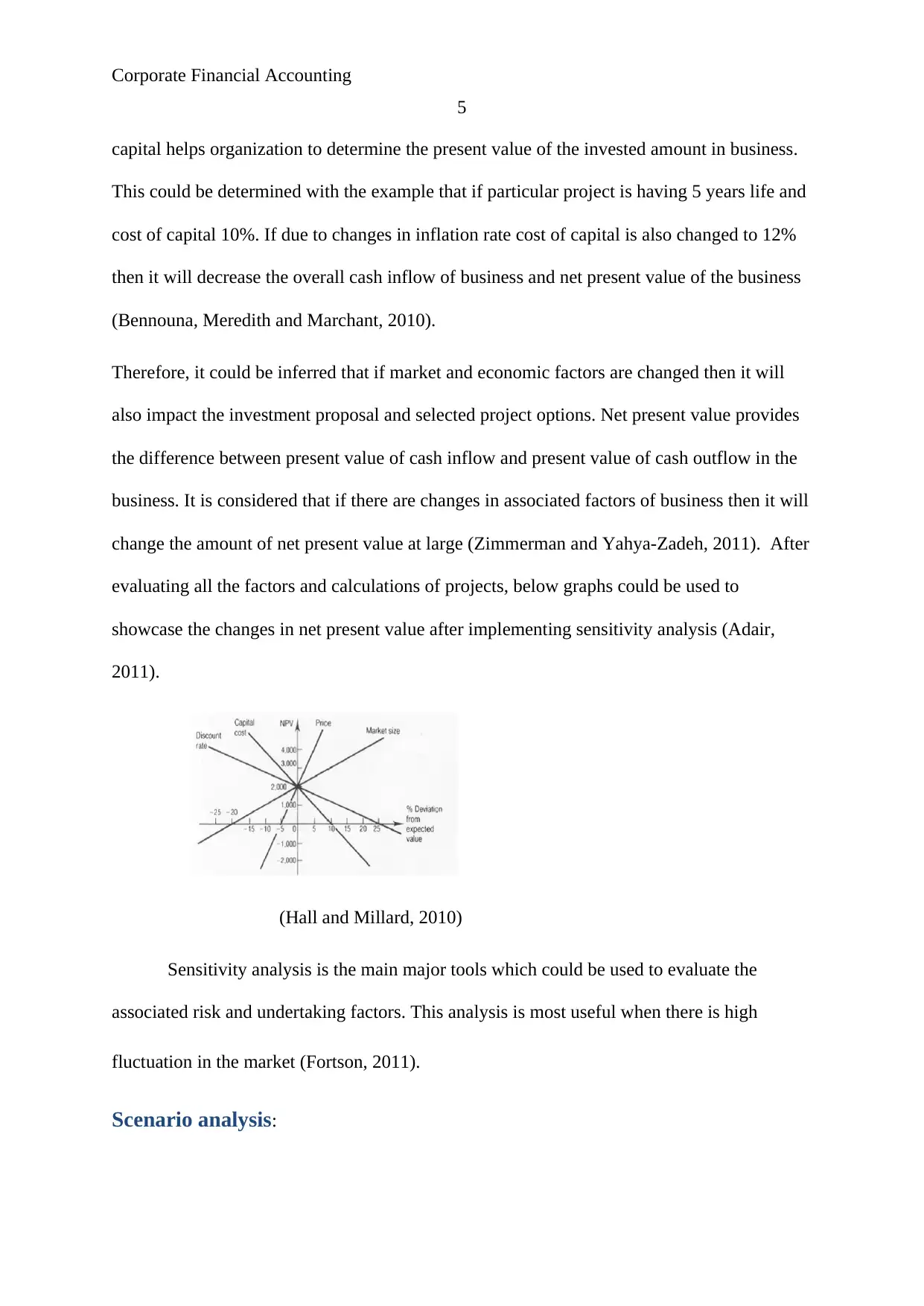
Corporate Financial Accounting
5
capital helps organization to determine the present value of the invested amount in business.
This could be determined with the example that if particular project is having 5 years life and
cost of capital 10%. If due to changes in inflation rate cost of capital is also changed to 12%
then it will decrease the overall cash inflow of business and net present value of the business
(Bennouna, Meredith and Marchant, 2010).
Therefore, it could be inferred that if market and economic factors are changed then it will
also impact the investment proposal and selected project options. Net present value provides
the difference between present value of cash inflow and present value of cash outflow in the
business. It is considered that if there are changes in associated factors of business then it will
change the amount of net present value at large (Zimmerman and Yahya-Zadeh, 2011). After
evaluating all the factors and calculations of projects, below graphs could be used to
showcase the changes in net present value after implementing sensitivity analysis (Adair,
2011).
(Hall and Millard, 2010)
Sensitivity analysis is the main major tools which could be used to evaluate the
associated risk and undertaking factors. This analysis is most useful when there is high
fluctuation in the market (Fortson, 2011).
Scenario analysis:
5
capital helps organization to determine the present value of the invested amount in business.
This could be determined with the example that if particular project is having 5 years life and
cost of capital 10%. If due to changes in inflation rate cost of capital is also changed to 12%
then it will decrease the overall cash inflow of business and net present value of the business
(Bennouna, Meredith and Marchant, 2010).
Therefore, it could be inferred that if market and economic factors are changed then it will
also impact the investment proposal and selected project options. Net present value provides
the difference between present value of cash inflow and present value of cash outflow in the
business. It is considered that if there are changes in associated factors of business then it will
change the amount of net present value at large (Zimmerman and Yahya-Zadeh, 2011). After
evaluating all the factors and calculations of projects, below graphs could be used to
showcase the changes in net present value after implementing sensitivity analysis (Adair,
2011).
(Hall and Millard, 2010)
Sensitivity analysis is the main major tools which could be used to evaluate the
associated risk and undertaking factors. This analysis is most useful when there is high
fluctuation in the market (Fortson, 2011).
Scenario analysis:
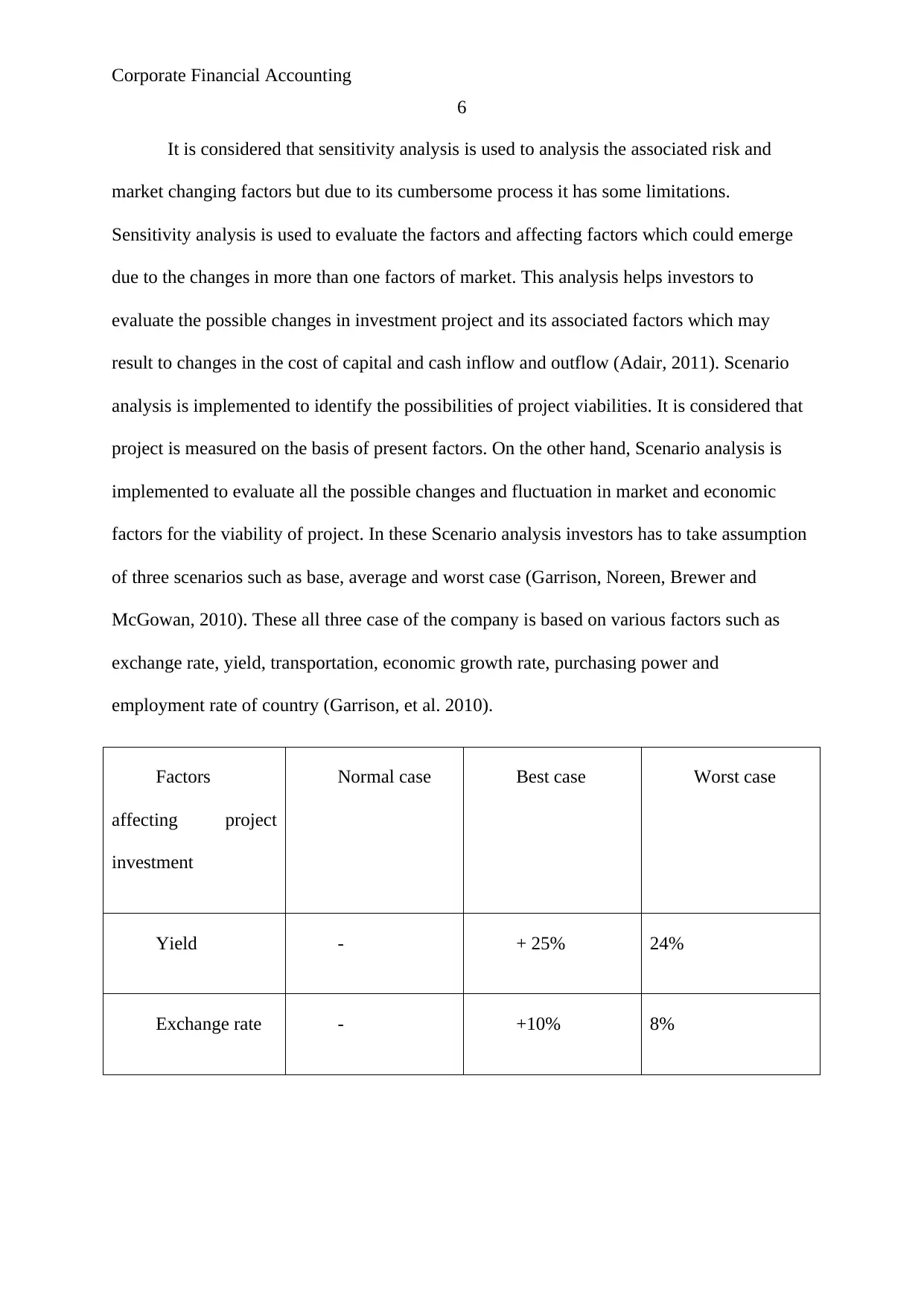
Corporate Financial Accounting
6
It is considered that sensitivity analysis is used to analysis the associated risk and
market changing factors but due to its cumbersome process it has some limitations.
Sensitivity analysis is used to evaluate the factors and affecting factors which could emerge
due to the changes in more than one factors of market. This analysis helps investors to
evaluate the possible changes in investment project and its associated factors which may
result to changes in the cost of capital and cash inflow and outflow (Adair, 2011). Scenario
analysis is implemented to identify the possibilities of project viabilities. It is considered that
project is measured on the basis of present factors. On the other hand, Scenario analysis is
implemented to evaluate all the possible changes and fluctuation in market and economic
factors for the viability of project. In these Scenario analysis investors has to take assumption
of three scenarios such as base, average and worst case (Garrison, Noreen, Brewer and
McGowan, 2010). These all three case of the company is based on various factors such as
exchange rate, yield, transportation, economic growth rate, purchasing power and
employment rate of country (Garrison, et al. 2010).
Factors
affecting project
investment
Normal case Best case Worst case
Yield - + 25% 24%
Exchange rate - +10% 8%
6
It is considered that sensitivity analysis is used to analysis the associated risk and
market changing factors but due to its cumbersome process it has some limitations.
Sensitivity analysis is used to evaluate the factors and affecting factors which could emerge
due to the changes in more than one factors of market. This analysis helps investors to
evaluate the possible changes in investment project and its associated factors which may
result to changes in the cost of capital and cash inflow and outflow (Adair, 2011). Scenario
analysis is implemented to identify the possibilities of project viabilities. It is considered that
project is measured on the basis of present factors. On the other hand, Scenario analysis is
implemented to evaluate all the possible changes and fluctuation in market and economic
factors for the viability of project. In these Scenario analysis investors has to take assumption
of three scenarios such as base, average and worst case (Garrison, Noreen, Brewer and
McGowan, 2010). These all three case of the company is based on various factors such as
exchange rate, yield, transportation, economic growth rate, purchasing power and
employment rate of country (Garrison, et al. 2010).
Factors
affecting project
investment
Normal case Best case Worst case
Yield - + 25% 24%
Exchange rate - +10% 8%
⊘ This is a preview!⊘
Do you want full access?
Subscribe today to unlock all pages.

Trusted by 1+ million students worldwide
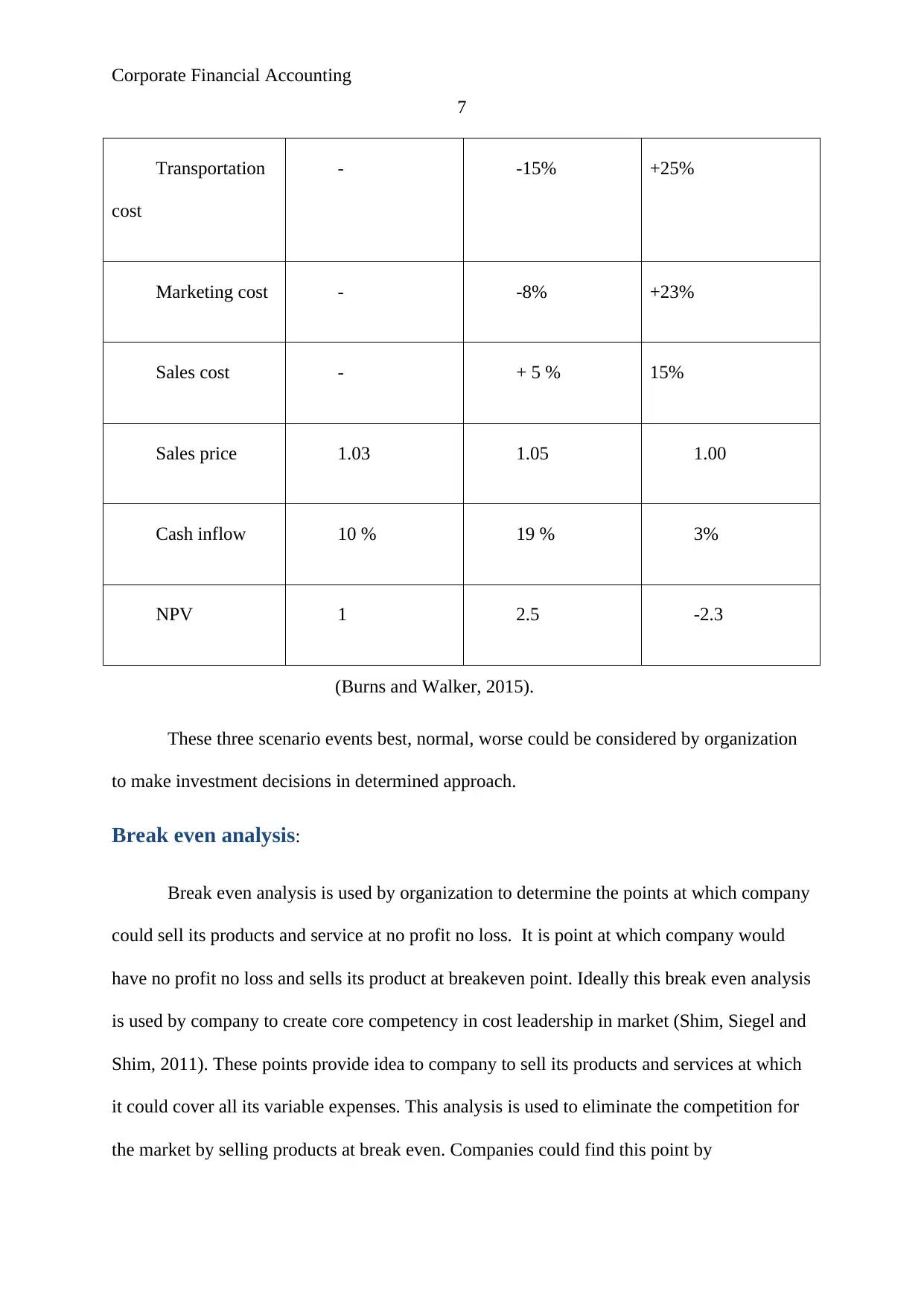
Corporate Financial Accounting
7
Transportation
cost
- -15% +25%
Marketing cost - -8% +23%
Sales cost - + 5 % 15%
Sales price 1.03 1.05 1.00
Cash inflow 10 % 19 % 3%
NPV 1 2.5 -2.3
(Burns and Walker, 2015).
These three scenario events best, normal, worse could be considered by organization
to make investment decisions in determined approach.
Break even analysis:
Break even analysis is used by organization to determine the points at which company
could sell its products and service at no profit no loss. It is point at which company would
have no profit no loss and sells its product at breakeven point. Ideally this break even analysis
is used by company to create core competency in cost leadership in market (Shim, Siegel and
Shim, 2011). These points provide idea to company to sell its products and services at which
it could cover all its variable expenses. This analysis is used to eliminate the competition for
the market by selling products at break even. Companies could find this point by
7
Transportation
cost
- -15% +25%
Marketing cost - -8% +23%
Sales cost - + 5 % 15%
Sales price 1.03 1.05 1.00
Cash inflow 10 % 19 % 3%
NPV 1 2.5 -2.3
(Burns and Walker, 2015).
These three scenario events best, normal, worse could be considered by organization
to make investment decisions in determined approach.
Break even analysis:
Break even analysis is used by organization to determine the points at which company
could sell its products and service at no profit no loss. It is point at which company would
have no profit no loss and sells its product at breakeven point. Ideally this break even analysis
is used by company to create core competency in cost leadership in market (Shim, Siegel and
Shim, 2011). These points provide idea to company to sell its products and services at which
it could cover all its variable expenses. This analysis is used to eliminate the competition for
the market by selling products at break even. Companies could find this point by
Paraphrase This Document
Need a fresh take? Get an instant paraphrase of this document with our AI Paraphraser
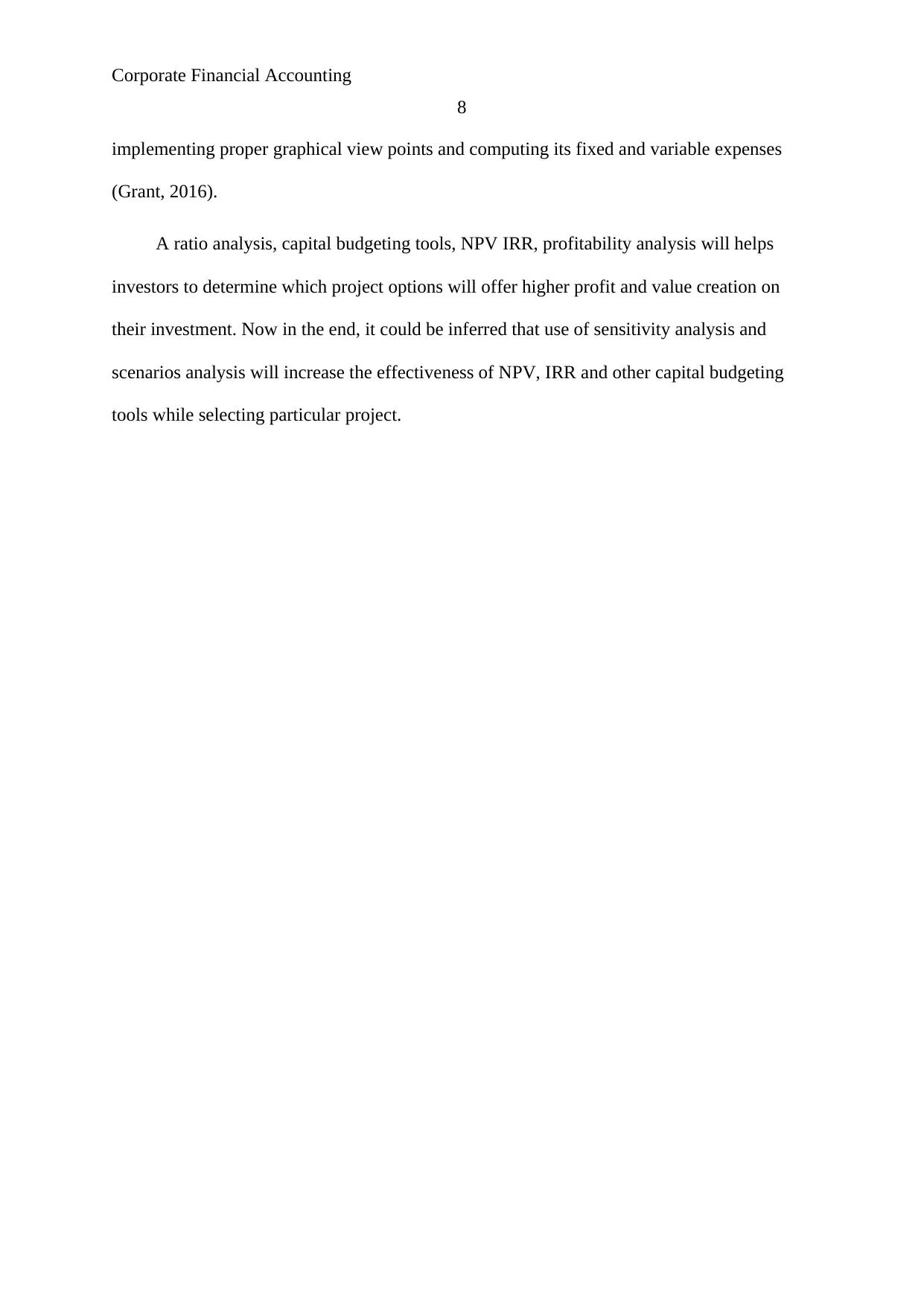
Corporate Financial Accounting
8
implementing proper graphical view points and computing its fixed and variable expenses
(Grant, 2016).
A ratio analysis, capital budgeting tools, NPV IRR, profitability analysis will helps
investors to determine which project options will offer higher profit and value creation on
their investment. Now in the end, it could be inferred that use of sensitivity analysis and
scenarios analysis will increase the effectiveness of NPV, IRR and other capital budgeting
tools while selecting particular project.
8
implementing proper graphical view points and computing its fixed and variable expenses
(Grant, 2016).
A ratio analysis, capital budgeting tools, NPV IRR, profitability analysis will helps
investors to determine which project options will offer higher profit and value creation on
their investment. Now in the end, it could be inferred that use of sensitivity analysis and
scenarios analysis will increase the effectiveness of NPV, IRR and other capital budgeting
tools while selecting particular project.

Corporate Financial Accounting
9
References:
Adair, T., 2011. Corporate Finance Demystified 2/E. McGraw Hill Professional.
Bennouna, K., Meredith, G.G. and Marchant, T., 2010. Improved capital budgeting decision
making: evidence from Canada. Management decision, 48(2), pp.225-247.
Bierman Jr, H. and Smidt, S., 2012. The capital budgeting decision: economic analysis of
investment projects. Routledge.
Bodie, Z., 2013. Investments. McGraw-Hill.
Burns, R. and Walker, J., 2015. Capital budgeting surveys: the future is now.
Fortson, J.G., 2011. Mortality risk and human capital investment: The Impact of HIV/AIDS
in Sub-Saharan Africa. The Review of Economics and Statistics, 93(1), pp.1-15.
Garrison, R.H., Noreen, E.W., Brewer, P.C. and McGowan, A., 2010. Managerial
accounting. Issues in Accounting Education, 25(4), pp.792-793.
Gervais, S., Heaton, J.B. and Odean, T., 2011. Overconfidence, compensation contracts, and
capital budgeting. The Journal of Finance, 66(5), pp.1735-1777.
Godfray, H.C.J., Beddington, J.R., Crute, I.R., Haddad, L., Lawrence, D., Muir, J.F., Pretty,
J., Robinson, S., Thomas, S.M. and Toulmin, C., 2010. Food security: the challenge of
feeding 9 billion people. science, 327(5967), pp.812-818.
Grant, R.M., 2016. Contemporary Strategy Analysis Text Only. John Wiley & Sons.
Hall, J. and Millard, S., 2010. Capital budgeting practices used by selected listed South
African firms, 2013. South African Journal of Economic and Management Sciences, 13(1),
pp.85-97.
9
References:
Adair, T., 2011. Corporate Finance Demystified 2/E. McGraw Hill Professional.
Bennouna, K., Meredith, G.G. and Marchant, T., 2010. Improved capital budgeting decision
making: evidence from Canada. Management decision, 48(2), pp.225-247.
Bierman Jr, H. and Smidt, S., 2012. The capital budgeting decision: economic analysis of
investment projects. Routledge.
Bodie, Z., 2013. Investments. McGraw-Hill.
Burns, R. and Walker, J., 2015. Capital budgeting surveys: the future is now.
Fortson, J.G., 2011. Mortality risk and human capital investment: The Impact of HIV/AIDS
in Sub-Saharan Africa. The Review of Economics and Statistics, 93(1), pp.1-15.
Garrison, R.H., Noreen, E.W., Brewer, P.C. and McGowan, A., 2010. Managerial
accounting. Issues in Accounting Education, 25(4), pp.792-793.
Gervais, S., Heaton, J.B. and Odean, T., 2011. Overconfidence, compensation contracts, and
capital budgeting. The Journal of Finance, 66(5), pp.1735-1777.
Godfray, H.C.J., Beddington, J.R., Crute, I.R., Haddad, L., Lawrence, D., Muir, J.F., Pretty,
J., Robinson, S., Thomas, S.M. and Toulmin, C., 2010. Food security: the challenge of
feeding 9 billion people. science, 327(5967), pp.812-818.
Grant, R.M., 2016. Contemporary Strategy Analysis Text Only. John Wiley & Sons.
Hall, J. and Millard, S., 2010. Capital budgeting practices used by selected listed South
African firms, 2013. South African Journal of Economic and Management Sciences, 13(1),
pp.85-97.
⊘ This is a preview!⊘
Do you want full access?
Subscribe today to unlock all pages.

Trusted by 1+ million students worldwide
1 out of 9
Related Documents
Your All-in-One AI-Powered Toolkit for Academic Success.
+13062052269
info@desklib.com
Available 24*7 on WhatsApp / Email
![[object Object]](/_next/static/media/star-bottom.7253800d.svg)
Unlock your academic potential
Copyright © 2020–2025 A2Z Services. All Rights Reserved. Developed and managed by ZUCOL.





